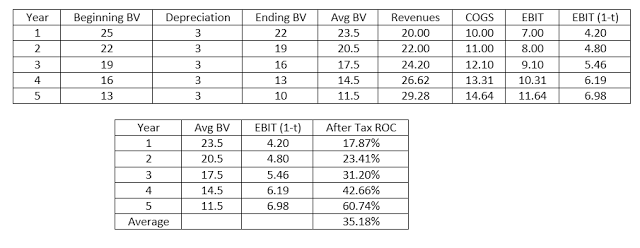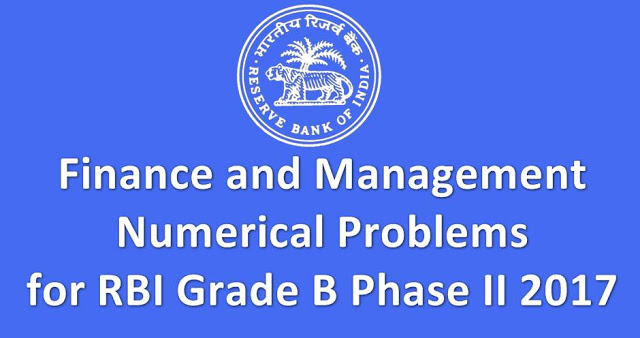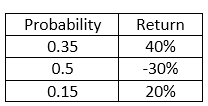Hello and welcome to exampundit. Here is a set of Finance and Management Numerical Problems for RBI Grade B Phase II 2017 provided by Oliveboard.
yield of 10%. The number of days to maturity is 91. What is the price?
to provide a dividend of Rs. 2.00 and fetch a price of Rs. 18 after one year.
What price would it sell for now if investors’ required a rate of return equal
to 12%?
investment in the project will be Rs 25 crore, and the investment will be
depreciated straight line, down to a salvage value of Rs 10 crore at the end of
the fifth year. The revenues are expected to be Rs 20 crore next year and to
grow 10% a year after that for the remaining 4 years. The cost of goods sold,
excluding depreciation, is expected to be 50% of revenues. The tax rate is 40%.
Estimate the after-tax return on capital, on average, for the project.
Corp, is planning to repurchase part of its common stock in the open market by
issuing corporate debt. The debt-to-equity ratio is expected to rise from 40
percent to 50 percent. The annual interest payment on its outstanding debt
amounts to Rs 4.5 crore with an interest rate at 10 percent. The expected
earnings before interest are Rs 22.5 crore. There are no taxes. What is the
expected return on equity after the announcement of the stock?
deviation and variation. The variance of the market return is the expected
squared deviation from the expected return. The Standard deviation is nothing
but the square root of the variance.
What is the expected standard deviation for the
portfolio? (Closest to nearest integer)
Question 1
Answer key: 2
Solution:
Note : T-Bills are sold at a discount, therefore, the gain without any coupons = (100 – Price)/Price
Annualized gain % or discounted yield = gain x 365 x 100 / days to maturity
Discounted yield = (100-Price¬) x 365 x 100/ (Price x Days to maturity)
10 = (100-Price) x 365 x 100/Price x 91
910P = 36500(100 – P)
37410P = 3650000
P = 97.57
Question 2
Answer key: 3
Solution:

Question 3
Answer key: 4
Solution: Average BV = (Beginning BV + Ending BV)/2
EBIT = Revenue – COGS – Depreciation
Since tax rate is 40%, EBIT after tax = (1 – 0.4) x EBIT

Question 4
Answer key: 3
Solution:
Interest payment = 4.5 crore = Debt x 0.10
Debt = 4.5 / 0.1 = 45 crore
D / E = 0.40 before the restructuring
E = Debt / 0.40
Equity = 112.5 crore
Therefore, Value = D + E = 45 + 112.5 = 157.5 crore
Also, Equity = Earnings to shareholders / return (equity)
Earnings to shareholders = Earnings before interest – Interest = 22.5 – 4.5 = 18 crore
Return (Before repurchase) = Earnings / Equity = 18 / 112.5 x 100 = 16%
After repurchase:
In the absence of taxes, the value of the firm will remain 157.5, because the additional interest tax is zero.
Debt = ½ Equity = 1/3 Value = 157.5/3 = 52.5 crore
Interest payments = 0.10 x 52.5 = 5.25
Earnings to shareholders = 22.5 – 5.25 = 17.25 crore
Return (equity) = Earnings/ Equity = 17.25 / (52.5 x 2) x 100 = 16.43%
Question 5
Answer key: 2
Solution:
Note: This entire quiz is provided by Oliveboard.
For more F&M numericals and 15 All India Tests for ESI + F&M, visit Oliveboard
ep
Recommended Test Series
(adsbygoogle = window.adsbygoogle || []).push({});
Regards
Team ExamPundit





